Experimental infection of horses with Hendra virus/Australia/horse/2008/Redlands
- PMID: 22172152
- PMCID: PMC3311212
- DOI: 10.3201/eid1712.111162
Experimental infection of horses with Hendra virus/Australia/horse/2008/Redlands
Abstract
Hendra virus (HeV) is a highly pathogenic zoonotic paramyxovirus harbored by Australian flying foxes with sporadic spillovers directly to horses. Although the mode and critical control points of HeV spillover to horses from flying foxes, and the risk for transmission from infected horses to other horses and humans, are poorly understood, we successfully established systemic HeV disease in 3 horses exposed to Hendra virus/Australia/Horse/2008/Redlands by the oronasal route, a plausible route for natural infection. In 2 of the 3 animals, HeV RNA was detected continually in nasal swabs from as early as 2 days postexposure, indicating that systemic spread of the virus may be preceded by local viral replication in the nasal cavity or nasopharynx. Our data suggest that a critical factor for reducing HeV exposure risk to humans includes early consideration of HeV in the differential diagnosis and institution of appropriate infection control procedures.
Figures






Similar articles
-
Routes of Hendra Virus Excretion in Naturally-Infected Flying-Foxes: Implications for Viral Transmission and Spillover Risk.PLoS One. 2015 Oct 15;10(10):e0140670. doi: 10.1371/journal.pone.0140670. eCollection 2015. PLoS One. 2015. PMID: 26469523 Free PMC article.
-
Hendra virus: a one health tale of flying foxes, horses and humans.Future Microbiol. 2013 Apr;8(4):461-74. doi: 10.2217/fmb.13.19. Future Microbiol. 2013. PMID: 23534359 Review.
-
Landscape Utilisation, Animal Behaviour and Hendra Virus Risk.Ecohealth. 2016 Mar;13(1):26-38. doi: 10.1007/s10393-015-1066-8. Epub 2015 Sep 24. Ecohealth. 2016. PMID: 26403793
-
Hendra virus.Vet Clin North Am Equine Pract. 2014 Dec;30(3):579-89. doi: 10.1016/j.cveq.2014.08.004. Epub 2014 Sep 30. Vet Clin North Am Equine Pract. 2014. PMID: 25281398 Free PMC article. Review.
-
Hendra Virus Infection in Dog, Australia, 2013.Emerg Infect Dis. 2015 Dec;21(12):2182-5. doi: 10.3201/eid2112.151324. Emerg Infect Dis. 2015. PMID: 26583697 Free PMC article.
Cited by
-
Dual microRNA Screens Reveal That the Immune-Responsive miR-181 Promotes Henipavirus Entry and Cell-Cell Fusion.PLoS Pathog. 2016 Oct 26;12(10):e1005974. doi: 10.1371/journal.ppat.1005974. eCollection 2016 Oct. PLoS Pathog. 2016. PMID: 27783670 Free PMC article.
-
Equine viral encephalitis: prevalence, impact, and management strategies.Vet Med (Auckl). 2019 Aug 7;10:99-110. doi: 10.2147/VMRR.S168227. eCollection 2019. Vet Med (Auckl). 2019. PMID: 31497528 Free PMC article.
-
Hendra virus: Epidemiology dynamics in relation to climate change, diagnostic tests and control measures.One Health. 2021 Jun;12:100207. doi: 10.1016/j.onehlt.2020.100207. Epub 2020 Dec 21. One Health. 2021. PMID: 33363250 Free PMC article. Review.
-
Detailed morphological characterisation of Hendra virus infection of different cell types using super-resolution and conventional imaging.Virol J. 2014 Nov 27;11:200. doi: 10.1186/s12985-014-0200-5. Virol J. 2014. PMID: 25428656 Free PMC article.
-
Recombinant Hendra viruses expressing a reporter gene retain pathogenicity in ferrets.Virol J. 2013 Mar 25;10:95. doi: 10.1186/1743-422X-10-95. Virol J. 2013. PMID: 23521919 Free PMC article.
References
-
- Department of Employment, Economic Development and Innovation, Biosecurity Queensland. Guidelines for veterinarians handling potential Hendra virus infection in horses. Version 4.1 2011. [cited 2011 Jul 22]. http://www.dpi.qld.gov.au/documents/Biosecurity_GeneralAnimalHealthPests...
Publication types
MeSH terms
LinkOut - more resources
Full Text Sources
Other Literature Sources
